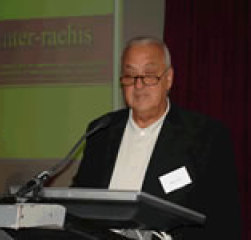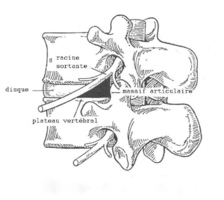
TRANSFORAMINAL ENDOSCOPIC DISCECTOMY
AFTER FAILED BACK SURGERY SYNDROME (F.B.S.S.)
(E. GOZLAN, Paris; M. FORGERIT, Niort; B.LAVIGNOLLE, Bordeaux;
O. RICART, Thionville; V. LAVIGNOLLE-AURILLAC, Bordeaux)
ISMISS, Zurich- Jan. 2009
STUDY DESIGN:
A multicentric study concerning 125 cases still suffering from a radiculopathy after interlaminar open surgery, have been evaluated at 3 and 12 months after Transforaminal Endoscopic Discectomy (T.E.D.).
PURPOSE
To evaluate efficacy and safety of TED, after failure of translaminar open surgery.
SUMMARY OF BACKGROUND DATA
This study follows a multicenter study of selective lumbar endoscopic discectomy published in December 2005 at the French GIEDA’s congress, concerning 644 patients presenting a radiculopathy secondary to a lumbar disc herniation treated by the Y.E.S.S. technique.
This study included all sorts of herniations and the senior author reported a series of 46 patients presenting a F.B.S.S. and with a success rate of 87% after TED.
METHOD:
This study concerns 125 patients presenting FBSS and evaluated 3 and 12 months after their index operation.
A provocative discography was systematically performed.
Sex ratio was M/F = 65/60 Average duration of the symptoms was 17.46 months. 13 patients had TED at 2 levels and 30 patients had foraminoplasty associated.
The radiological findings (MRI, SCAN, Discography) showed: 74 recurrences at same level, 6 sequestered fragments, 16 foraminal herniations, 30 foraminal stenoses, 13 disk herniations at another level.
RESULTS:
At 3 months post operatively we noted that:
- The neurological signs had disappeared in 76% of the cases.
- The radicular pain was reduced in average by 74% on the AVS and the lumbar pain by 48%. - The DALLAS score was reduced by 40% (112 cases), and the OSWESTRY score (17 cases) was also reduced by 75%.
- Also, 79% of the patients considered the result as a success.
At 12 months post operatively (79 patients) the results were:
- Decrease of the radicular pain in average by 83% and 68% for lumbar pain.
- Reduction of the DALLAS score by 48%.
- Also, 87% of the patients considered the result as a success.
- No major complications appeared in this study.
CONCLUSION:
In our experience, results are poor after second open surgery.
The transforaminal approach, to treat persistent radiculopathy after FBSS can be recommended. The main advantage of this technique is to avoid a second transcanal effraction, and the risk of scarring complications.
The MRI doesn’t always help in the diagnosis, as the presence of intracanal scar tissue can mask a disc herniation. In those cases, provocative discography is indispensable, being the only test able to reveal a remaining or recurrent symptomatic disc herniation.
Also, very careful thermomodulation must be used especially in case of previous open surgery, because of neoneurogenesis and angiogenesis, often found in the disc cavity after extracting inflamed disc fragments, and causing discogenic pain.

